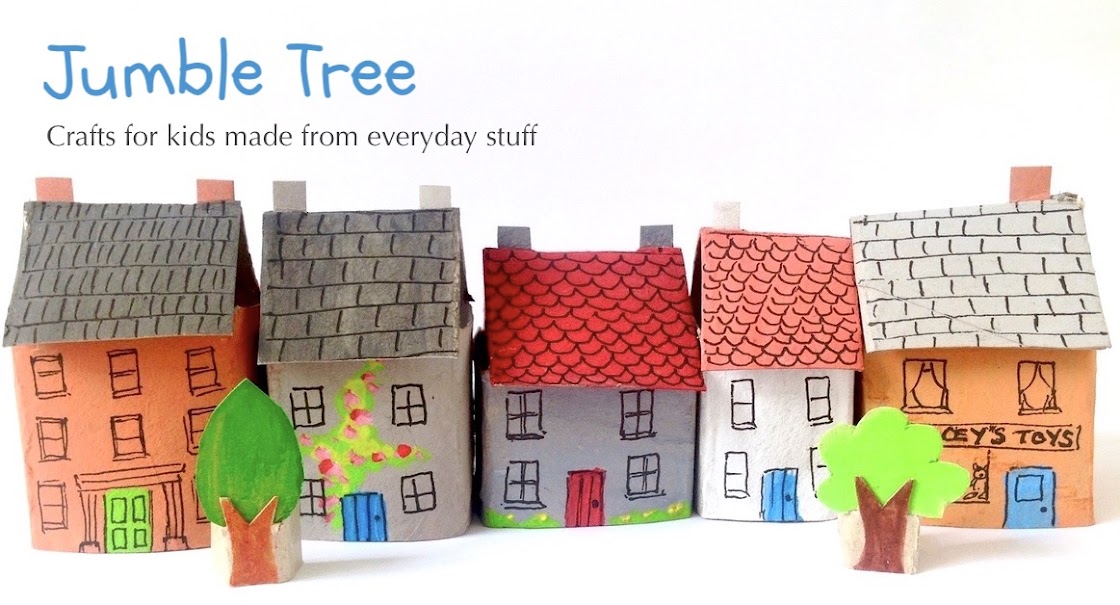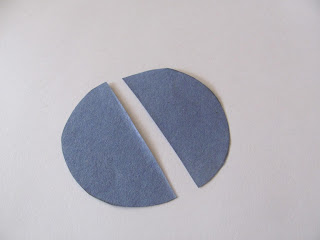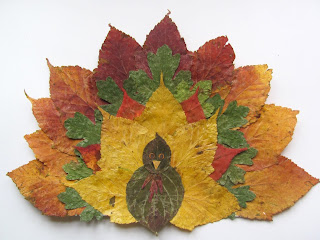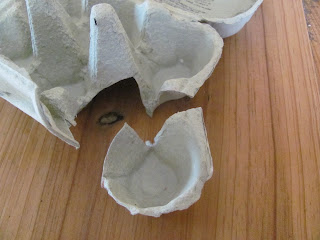11.12.18
Simple cork craft for Christmas!
...well, it is that time of year when there might be a few corks knocking about!
This is a very simple Santa craft, based on the gnomes from 'Brian the Lion goes into Space' - so if you'd like to make one, follow the step-by-step instructions for a gnome here.
The only changes are:
Paint the top part of your cork a pinky colour for the face (mix a little red with lots of white, a spot of yellow and tiny touch of blue).
Either paint the bottom part red, or use red paper. Instead of blue feet/shoes, use black paper (or colour-in some plain paper).
For a little extra detail, tease out a thin strip of cotton wool and glue it around the bottom of the cork. Use a black pen to draw a belt around his middle. Add a tiny ball of cotton wool to the top of Santa's red hat.
6.12.18
How to make the gnomes from Brian the Lion
It's the gnomes turn to take centre stage!
There's already a Brian the Lion tutorial here, and this project shows you how to make the little blue, beardy gnomes that Brian meets during his adventures in my book, 'Brian the Lion goes into Space.'
They're very simple to do - just corks and cotton wool!
You will need:
Cork (wine cork shape or cava/champagne shape)
Paint
Scissors
Blue paper (or plain paper coloured blue)
Cotton wool
Glue stick
PVA craft glue
Black felt-tip pen or gel pen
1. First, paint your cork light blue (mix a little blue with a lot of white) The champagne style corks have an obvious head shape.
2. Cut a strip of blue paper (or colour-in plain paper) Make it few cm's wide, so it's about half the length of the cork. Cut a piece that's long enough to wrap around the cork with a little overlap.
3. If you have a glue stick, rub this over your strip of paper and glue in place. With craft (pva) glue, it might be easier to brush a thin layer on the bottom half of the cork and wrap your paper piece around it, adding a tiny dab more glue where the paper overlaps.
4. Cut another thinner strip for the arms - it needs to go around the back of the cork with the arm length even on both sides. You can round off the strip ends for hands if you want, or leave them as they are. Glue in place.
5. For the gnome's shoes, place the cork on the paper and draw around it, but extend your circle shape out a bit at the front (see pic)
Cut out, and mark a 'V' shape in the middle of extra front bit that sticks out, to define the shoes. Snip out the 'V'. Glue the rest under the cork.
6. For the gnome's beard, take a small piece of cotton wool - we unwrapped a cotton ball and used one end of it. Decide how long you want your gnome's beard to be, then gently pull a hole in the cotton wool just above your chosen beard size.
7. Brush a layer of craft glue over the top and sides of the gnome's head and a little on his front, below his head, but leave a space for his face. Carefully press the cotton wool into place, around the face. Try not to get glue on your hands or his beard will stick to your fingers! Gently tease the cotton wool down at the back and sides, to cover the head, and cut any extra off. Press and trim the front too, until you're happy.
For the gnome's hat, draw around something like the base of a small glass, or jar or beaker, and cut the circle out. Fold it in half and cut along the crease. Rub or dab some glue along half the straight edge and carefully fold and bring the sides together to make a small cone shape. Press with your fingers until the glue holds.
You could glue the hat on, or leave it, so your gnome can take a nap.
Because of course, they sleep on their heads...
20.11.18
Leaf art using paper plates
We have done a fair bit of leaf art over the years, but this is a little different because we've used paper plates as a base for the leaves, and this helps so much with the shape of the birds. A lot easier for little makers too.
We pressed our leaves so they're flat to work with and last longer. The downside is they lose some of their vibrant colour and can sometimes be brittle, but it is lovely to be able to keep your leaf art - we still have a butterfly I made with Daisy about 6 years ago!
There's lots of advice online about the best ways to press leaves - ours isn't very scientific! We just arranged them between some sheets of newspaper and put the newspaper under a rug in the kitchen for about a week. Seemed to work okay..
Just make sure you have plenty of leaves and they're different colours and shapes.
For the Thanksgiving Turkey, cut a small section off the bottom of a paper plate.
Then start with the top of the fantail, arranging your leaves along the outer edge of the paper plate so you can't see any white. Think about your colours, it is worth spending a few minutes arranging your leaves into colour piles. We started with reddish orange leaves, then a row of green and then red point leaves and finally yellow. So a darker turkey body would stand out.
Once you've decided on your rows of leaves - brush a good layer of PVA glue onto the paper plate and stick the leaves down - you will probably need to brush a little glue on the overlapping leaves too.
Find a big leave for the turkey body and a smaller one for the head - make sure they stand out against the fantail.
We used small red leaves for the turkey wattle and cut a small triangle for the beak. If your turkey body is light enough you could draw on eyes with a pen, but if it's dark like ours, then use a hole punch to cut two small circles out of a light coloured leaf and colour in the pupils with a black pen.
Rub a bit of glue stick or brush a very thin layer of glue on the Turkey's face, wet your finger to make it easier to pick up the little leaf pieces, and stick them in place.
Put your Turkey plate collage under a book or tray to press it down. Our turkey looks rather dwarfed by its enormous fantail!!
The hen is based on our recent paper plate hen project. Remove about a third of the plate by cutting away a curved piece from the top, like so. This will give you your basic hen shape.
Brush your paper plate with a good layer of glue and cover the whole thing with overlapping yellow and greenish leaves. You may need to brush more glue on overlapping leaves.
We found oak leaves were great for the hen's fluffy plumage at the back. Let your leaves go over the edge of the plate to cover the line and to give a more fluffy, feathery look. If too much leaf goes over the edge, you can always give it a trim.
You can keep going, but we put our hen under a book to press for a while, before moving onto the wing and head stage.
Chose a nice big leaf for the wing - find some small colourful leaves and arrange and glue them under the edge of the big leaf, before adding to your hen.
Use some thin pointy red leaves for the hen's comb and arrange and glue them underneath the top of the head. Fine a yellow/orange leaf with a strong pointy end for the beak and stick this underneath too (cut away the part of the leaf you don't need).
Use small red leaves for the wattle, trim if you need to, and glue this just under the beak.
Use a black pen to draw on an eye.
6.11.18
Poppy egg carton craft for Remembrance Day
This craft project is close to my heart. As an army wife I can't think about Remembrance Day without getting a lump in my throat. Such a mix of emotions, as we honour those who died in the First and Second World Wars and all the conflicts since, and I remember family and friends in the Forces. Some here, some not.
These poppies are made from egg cartons, and I've gone for three petals instead of four because I thought they looked more poppy-like. I've added a little paper centre too, for the spikey stamens, but you can leave this part out if you like.
You will need:
Egg carton
Scissors
Pencil
Craft glue (we used PVA)
Paint
Black paper (optional)
Paper plate (for the wreath)
Egg cartons come in all shapes and sizes and this does make a difference when you're trying to make flowers.
If the cups are nice and round, then it's easy enough to cut one out like this, with an neat edge and make three, roughly evenly spaced marks, for the gaps between the petals.
The thing is, most egg carton won't have nice round cups, they'll probably look a bit more like this when you cut them out, with a split where the cup joined the middle part of the carton.
So, we're going to work with the split, and incorporate it into our poppy, by using it as one of our three marks, adding two more so they'll all as evenly spaced as possible. (Cut off the rough edges at the top if they're in the way.)
With the scissors, cut down to the base of the egg cup where you've made your two marks.
Then cut and gently curve each of the three petals.
Carefully round off the edges of each petal by snipping the corners. And then very gently, while holding the flower in the middle, carefully push the petals back. This needs to be done with care or the cardboard can rip.
In the picture below I'm snipping off the corners of the round neat shaped egg carton cup.
In the end the round egg carton cup and the one with the splits look pretty similar!
Paint your poppies, remember to do the back of the petals as well, and add a black blob in the middle - this looks much better and more natural if it's a bit irregular, and not too perfect and round.
To make the wreath, paint the rim of a paper plate green. When it's dry, make a hole in the centre of the plate (best done by an adult) and cut out the middle section.
This next step is optional as the poppies look lovely as they are, but the little paper stamens gives them a bit more detail.
Cut a strip of black paper about 0.5-1cm wide and cut into 5cm pieces.
Roll one of the short pieces up, then open it and snip a fringe along one side - roll it up again, but loosely this time.
Brush a good layer of glue in the middle of black centre of your poppy and add the rolled up paper. Let it unfurl a little, but make sure it stays in the glue. Give it a light press and then leave your poppy to dry.
Once dry, press the fringed paper out with your finger. We made 15 poppies for our wreath.
Make a hole in your paper plate wreath and thread through some string so you can hang it up. Then glue on your poppies.
Subscribe to:
Posts (Atom)







































































